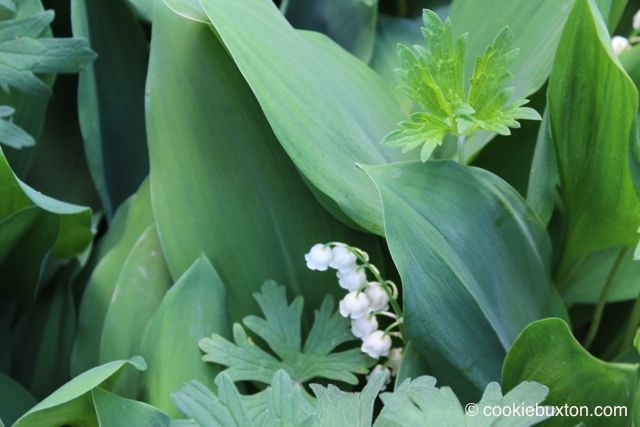Lily of the Valley
Convallaria majalis. Lily of the Valley.
If I were planting a brand new garden, one of the first assignments would be to find a stretch of shade to create a home for lily of the valley. Maybe it is because of our cold winters in the north, but I actually experience a sense of longing each spring for my two favourite smells in the flower world – lily of the valley, and lilac.
I like to collect four or five stems of these dainty, white, bell-shaped flowers from my garden, along with two or three of the attractive leaves, and bring these flowers as gifts to other people. Older people, who have known the flower for a long time, invariably pull these little bouquets to their faces and breathe in long and deeply.
The scent of the lily of the valley is sweet and lingering. Anyone coming into a room with a little vase of lily of the valley will find the smell of these flowers staying in memory for a long time. It is one of the highlights of gardening to have these lovely plants near at hand.
My lilies grow in the shade of a 20-foot pyramidal cedar. The soil underneath the cedar has, long ago, swung to the acidic side. The plants like the soil and do well here. They do, though, manage to push out easily from their main area and show up in the middle of the peony bed between my two cedars, and hustle their way towards my perennial geraniums and fleabane and baby’s breath nearby in the direct sun of the main garden. When I am short of time, I pluck out the leaves (after I have picked the flowers) without bothering to dig out the root of the invaders. This works reasonably well at controlling spread in the short term. Later, I have to go in with a spade and pull out the rhizomes – the horizontally spreading roots of the plant – to get the growth back under control.
This year, the lily of the valley roots have gone outside the yard, under my fence, and are stealing territory from the beautiful day lilies that line the back lane of my property. That is not an easy task to do, as the day lilies are also an invasive, take-this-piece-of-land-as-my-own kind of plant, and so the two will be struggling with each other for their share of the soil in this back stretch in the coming weeks. I will probably dig the lily of the valley out from this location (when I get some spare time), now that they have finished blooming.
Lily of the valley flowers do not bloom for long in my region. If the weather gets too hot, they flower for far too short of a period before the pretty white flowers fade and turn brown. If the weather is cooler, you will be fortunate to have a longer showing. Ten to 14 days is about all the time I get to enjoy these beauties in my garden. I do appreciate the leaves, though, after the flowers fade, as they remain upright and act as a handsome ground cover throughout the growing season.
Pink variation
Convallaria majalis ‘Rosea’ is a pink-flowered lily of the valley variation. I have not had the pleasure of seeing it, but have read that the flowers are more vividly pink when they first bloom, then lighten to a softer pink over time.
Lily of the valley is a poisonous plant
The lily-of-the-family plant has some toxic chemical properties with which one should be familiar. All parts of the plant are poisonous. The Nova Scotia Museum website features a web page called The Poison Plant Patch to help educate the public about the poisonous qualities of many wild and cultivated plants. To access this helpful information, visit the Nova Scotia Museum’s Poison Plant Patch web section and look up the various plants by their common or scientific names.
